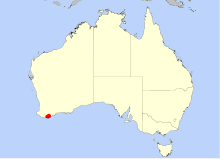Drosera dichrosepala
| Drosera dichrosepala | ||||||||||||
|---|---|---|---|---|---|---|---|---|---|---|---|---|

Drosera dichrosepala , flower |
||||||||||||
| Systematics | ||||||||||||
|
||||||||||||
| Scientific name | ||||||||||||
| Drosera dichrosepala | ||||||||||||
| Turcz. |
Drosera dichrosepala is a carnivorous plant of the genus sundew ( Drosera ). It was first described in 1854.
description
Drosera dichrosepala is a perennial herbaceous plant . This stalk-forming dwarf sundew reaches heights of growth of around 2 to 4 cm and a diameter of around 1.5 cm to almost 2 cm. Drosera dichrosepala forms a long taproot, buttop roots are occasionally formed above ground. The growing season of the plant is from May to the end of November / beginning of December. At high temperatures, the plant forms stipules ( stipuli ) in summer , which protect against the sun's rays.
The petioles are about 0.5 cm long. The round to oval catch leaves as well. The catch leaf has long edge tentacles (typical of dwarf sunnies) .
There are four to twelve white or pink flowers with a diameter of just under one centimeter on the flower stalk, which is up to four centimeters long . The five petals are relatively narrow (3 mm long and 1 mm wide). The flower can bloom for up to 3 days (does not close even at night) and has a sweet scent. Flowering time is September to October (so in the Australian spring).
The formation of brood scales is typical of dwarf sunnies : the circular, relatively thick brood scales are formed in large numbers from late November to early December and have a diameter of approx. 1.2 mm and a thickness of 0.8 mm.
The number of chromosomes is 2n = 12.
Distribution, habitat and status
The species is native to southwest Australia, north of Albany around Mount Barker . The climate there can be described as Mediterranean, it is characterized by cool, humid winters (temperatures between 10 and 20 ° C, precipitation around 100 mm) and warm, dry summers (temperatures between 15 and 25 ° C, precipitation around 50 mm) out. The soils are clayey.
Systematics
In addition to the nominate form , the subspecies Drosera dichrosepala subsp. enodes , which Allen Lowrie regards as a separate species, Drosera enodes . The name "dichrosepala" comes from the Greek and means two-colored sepals (dikhros = two-colored; sepala = sepal).
literature
- Allen Lowrie : Carnivorous Plants of Australia. Volume 2. University of Western Australia Press, Nedlands 1989, ISBN 0-85564-300-5 , p. 42.
- Ludwig Diels : Droseraceae (= The Plant Kingdom . 26 = 4, 112, ZDB -ID 846151-x ). Engelmann, Leipzig 1906, p. 109.
Individual evidence
- ↑ Drosera dichrosepala at Tropicos.org. In: IPCN Chromosome Reports . Missouri Botanical Garden, St. Louis

